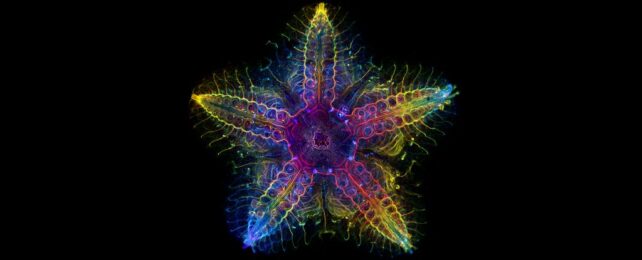We already knew that starfish were pretty weird. These strange, sea-dwelling animals seem to have rules unto themselves. They are brainless, bloodless, digest their food externally, and regenerate body parts, sometimes into whole other new starfish.
But none of those are the creepiest thing about them. According to a new analysis of their gene expression, starfish and other echinoderms lack the architecture for an actual body.
They are essentially just mobile heads that sprouted the ability to crawl, say a team led by biologists Laurent Formery and Chris Lowe of Stanford University.
"From the perspective of ectoderm patterning," the researchers write in their paper, "echinoderms are mostly head-like animals."
Echinoderms – that's not just starfish, but also sea urchins, sand dollars, sea cucumbers – are pretty common in the parts of the ocean humans frequent, so we tend to think of them as nothing unusual. If we think of them at all.
But they are very different from other animals. Their body symmetry is (usually) fivefold, rather than the bilateral 'left-right' symmetry we see in most creatures.

The oldest known starfish on the fossil record predates the earliest known dinosaurs by over 200 million years, so whatever it is they're doing, they're very, very good at it.
But their strange symmetry means that their bodies are difficult for us to figure out.
"How the different body parts of the echinoderms relate to those we see in other animal groups has been a mystery to scientists for as long as we've been studying them," says evolutionary biologist Jeff Thompson of the University of Southampton in the UK.
"In their bilateral relatives, the body is divided into a head, trunk, and tail. But just looking at a starfish, it's impossible to see how these sections relate to the bodies of bilateral animals."
The researchers undertook a molecular study to find out where echinoderms fit in the deuterostome superphylum, a large group of animals that includes both vertebrates and echinoderms.
Since deuterostomes evolved from a common ancestor, many millions of years ago, the researchers thought they may be able to track the way echinoderms evolved.
Their study was conducted on a species of sea star called Patiria miniata, or bat stars.
They used RNA tomography and a technique called in situ hybridization, in which scientists localize precise DNA and RNA sequences in a tissue sample. They used this information to create a three-dimensional map of gene expression in the body of the sea star as it grew.
They investigated a range of transcription factors that are in bilateral animals involved in the front-to-back development of the creature's body, a process known as anterior-posterior patterning. These genes were found in the sea star; they help develop the arms, from about the mid-region down to the tip.
But there was a glaring omission. In other deuterostomes, there is a set of genes that helps develop the trunk of the body.
"When we compared the expression of genes in a starfish to other groups of animals, like vertebrates, it appeared that a crucial part of the body plan was missing," Thompson explains.
"The genes that are typically involved in the patterning of the trunk of the animal weren't expressed in the ectoderm. It seems the whole echinoderm body plan is roughly equivalent to the head in other groups of animals."

The evolution of echinoderms has been difficult to understand, just based on the way their (head-) bodies are shaped. The new research suggests that, once upon a time, echinoderms may have had the tools to develop a body, but dropped it somewhere along their long history.
In their defense, it seems to have worked out pretty well for them.
But the new findings give scientists new tools for understanding why they are that way, and interpreting any fossils that emerge from eons past.
"Our research tells us the echinoderm body plan evolved in a more complex way than previously thought and there is still much to learn about these intriguing creatures," Thompson says.
"As someone who has studied them for the last ten years, these findings have radically changed how I think about this group of animals."
The research has been published in Nature.
